|

 The
Origin of the Zodiac: (Astrology) The
Origin of the Zodiac: (Astrology)
The zodiac (Greek: ζoδιακός, zōdiakos)
is the term used to describe the circle of twelve 30� divisions of celestial longitude that
are centred upon the ecliptic - the path of the
sun.
The term zodiac derives from
Latin zōdiacus, which in its turn comes from the
Greek ζoδιακoς κύκλος
(zōdiakos kuklos), meaning "circle of animals".
From the earliest of times, the
zodiac has been universally used to predict or reflect characteristics of
personality, whether from the Chinese, Mesopotamian, Indus
Valley, Egyptian or any other culture, echoing the ancient philosophy 'As
above - so below'... what we today call astrology.
Astrology, in its broadest sense, is the
search for purpose in the heavens.
We know from
ancient records that the Greeks inherited their knowledge of the
heavens primarily from the Mesopotamians, who in turn inherited
their knowledge from the Sumerians. But is there any evidence of
the heavenly constellations in art or culture from before this time.
Remarkably, it has been proposed that the images at Lascaux and
other nearby Palaeolithic sites show exactly that...
Learn how to understand the present value of growing perpetuity.
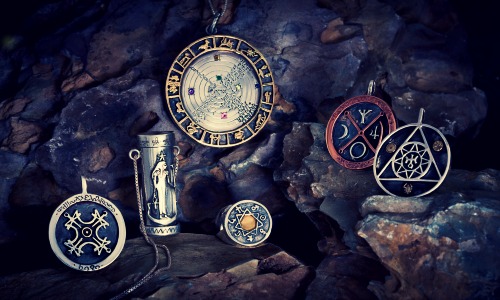
The Lascaux Planetarium.
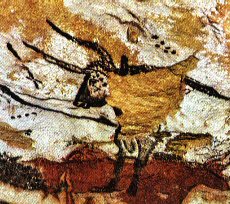 Near to the entrance of the Lascaux
cave complex is a magnificent painting of a bull. Hanging over its
shoulder is what appears (to us) to be a map of the Pleiades, the
cluster of stars sometimes called the Seven Sisters. Inside the bull
painting, there are also indications of spots that may be a
representation of other stars found in that region of sky. Today,
this region forms part of the constellation of Taurus the bull. Near to the entrance of the Lascaux
cave complex is a magnificent painting of a bull. Hanging over its
shoulder is what appears (to us) to be a map of the Pleiades, the
cluster of stars sometimes called the Seven Sisters. Inside the bull
painting, there are also indications of spots that may be a
representation of other stars found in that region of sky. Today,
this region forms part of the constellation of Taurus the bull.
In
recent years, new research has suggested that the Lascaux
paintings may incorporate prehistoric star charts. Dr
Michael Rappenglueck of the University of Munich argued that
some of the non-figurative dot clusters and dots within some
of the figurative images correlate with the constellations
of Taurus, The Pleiades and the grouping known as the
"Summer Triangle".
Based on her own study of the astronomical significance of
Bronze Age petroglyphs in the Vall�e des Merveilles and her
extensive survey of other prehistoric cave painting sites in
the region � most of which appear to have been specifically
selected because the interiors are illuminated by the
setting sun on the day of the winter solstice � French
researcher Chantal J�gues-Wolkiewiez has further proposed
that the gallery of figurative images in the Great Hall
represents an extensive star map and that key points on
major figures in the group correspond to stars in the main
constellations as they appeared in the Palaeolithic leading
to the
remarkable suggestion of a direct transfer of
information for over 17,000 years.
(More
about Lascaux, France)
|
The
Origin of the Zodiac: |
While there
are currently 88 constellations officially by the IUA recognised
today (9),
this page is concerned only with the origin of the 12
constellations that make up the modern zodiac.
The classical
map of the sky, with the 48 Greek constellations,
was derived from at least two different pre-Greek traditions.
One tradition comprised the 12 signs of the zodiac, with several
associated animal constellations, all of
which developed over 3,200-500 BC in Mesopotamia in a religious
or ritual tradition. These were taken over by the Greeks around
500 BC. However the other Babylonian
constellations, their farming-calendar tradition, were
not adopted. The other tradition was not Mesopotamian; it
comprised large constellations which
appear to date from 2,800 BC, probably from the Mediterranean
region, devised for the navigators of ships. They include huge
bears and serpents which marked the celestial pole and equator
at that time, and probably the four anonymous giants which we
know as Hercules, Ophiuchus, Bootes, and Auriga, as well as some
of the large southern 'marine' constellations.
The origins of some other constellations,
including the Perseus tableau and various animals, are unknown.
(11)
It is therefore currently concluded that among the Indo-European peoples, astrology dates
to the third millennium BC.
(4)
This is supported by the following research.
'There has been much speculation as to the
origin of the constellations. Until recently it has usually been
assumed that they evolved from the fancies of primitive
imaginations, but research now suggests that they were designed
as a pictorial scientific coordinate system. A coordinate system
is a set of imaginary lines for measuring positions, like the
lines of latitude and longitude for determining locations on the
earth. The constellations perform a similar function, but they
employ pictures, which make it easy to identify stars without
need of instruments. Moreover, this evidence points to a time
and place that they originated: about 2700 B.C at about 36�
north latitude. There are three main lines of evidence that
point to this date and location'.
(10)
The Empty Part of the sky. There is a circle of about 36�
radius in the southern part of the sky which does not contain
any of the original 48 constellations. That implies that the
originators of the constellations lived at about 36� north
latitude because at that location, exactly such an area of
southern sky would be invisible to them. Moreover, the centre of
that circle moves very slowly through the sky because of the
motion of the earth's axis. The location of the centre of the
empty part of the sky implies an origin date of about 2,900 B.C.
Slanted Constellations. Many of the constellations are
tipped at an angle to the natural directions of north, east,
south and west. If one asks if there was a time and place when
they would have all been much aligned vertically and
horizontally, the answer is, about 2,900 B.C. Note that this is
an entirely different line of reasoning, but it yields a very
similar date and location of origin. Moreover, several of the
constellations mark astronomically important areas at the date.
For example, the long snake Hydra would have coincided with the
circle called the celestial equator.
Star risings and settings. The ancient Greek poet
Aratus states that certain stars rise at the same time, or set
at the same time, or that one rises as another sets on opposite
points on the horizon. Because of the earth's precession, such
coincidences depend on both the location on the earth and on the
date of observations. Using statistical methods, it has been
found that Aratus was describing the stars at a latitude of
about 36� (within about 2�) at about 2,600 B.C. (within 800
years).
Evidence points
to an origin on Latitude 36�, which is near perfect for Sumeria (the
civilization from which Babylon inherited much of its science).
Accordingly, the Sumerians are currently credited with
originating the constellations. It is important to recognise
that the Sumerians also divided both time and space with the
Hexadecimal system resulting in a 360� division of the globe and
heavens.
(More
about the Sumerians)
Of particular
interest in relation to this is is the location of the capital
city of the Assyrian empire (Nimrud), which was founded by King
Shalmaneser I (1274 BC � 1245 BC). It became the Assyrian
religious capital in 875 BC by Ashurnasirpal II. It also happens
to be be placed 6� to the North and 12� to the East of the
Egyptian anchor point of Giza/Heliopolis
(12)
revealing the complex system of geodetic placement in operation
at that time (based on a 360� division of the globe).
Perhaps also no coincidence that the longitude of Nimrud is also the
same as the exterior angle of both Snoferu's pyramids.
Nimrud - (36� 06�
N, 43� 20� E).
(More
about Egyptian Geodesy)
The Babylonian MUL.APIN.
('The Shining Herd')
Having established
that astrology (the 12 constellations) originated in Sumeria, it is
worth investigating if this represents the true origins of the
zodiac. It is
known that Babylonian astrology developed within the context
of divination. A collection of 32 tablets with inscribed liver
models, dating from about 1,875 BC, are the oldest known detailed
texts of Babylonian divination, and these demonstrate the same
interpretational format as that employed in celestial omen analysis.
(6)
However, we are also told that another influence can be seen in
Sumeria from before that time, an influence that is suggestive of
geometry, longitude and latitude.
(11)
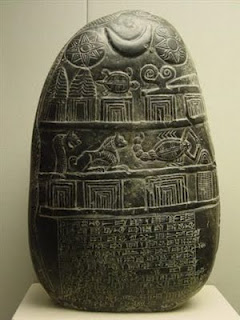
The Sumerians called the twelve
major zodiacal constellations the 'Shiny herd'.
|
Sumerian |
Translation |
Modern Name |
|
GU.AN.NA
MASH.TAB.BA
DUB
UR.GULA
AB.SIN
ZI.BA.AN.NA
GIR.TAB
PA.BIL (Archer)
SUHUR.MASH
GU
SIM.MAH
KU.MAL
|
Heavenly Bull
Twins
Pincers, Tongs
Lion
Her father was Sin
Heavenly Fate
Which claws and cuts
Defender
Goat-Fish
Lord of the waters
Fishes
Field dweller
|
Taurus
Gemini
Cancer
Leo
Virgo
Libra
Scorpio
Sagittarius
Capricorn
Aquarius
Pisces
Aries
|
(Right: Sumerian
astrology tablet, dating from c. 2,300 BC) Note the presence of
a lion and a crab in the central band.!
The first
official inscribed version of a Babylonian
compendium is from 86 BC, but by using modern astronomical
techniques an astronomer at Louisiana State University
has dated the original observations to 1,370 BC, give
or take 100 years. He also says the
observations were made within 100km of 35.1�
N. The tablets record
the day of the year that certain groups of stars, or
constellations, appear in the sky at dawn. These constellations
are widely thought to be the precursors of the modern Signs of
the Zodiac. (1),
However, Babylonian art is
resplendent with images of Lions, Scorpions, Rams, and Bulls,
dating back much further suggestive of a much earlier
recognition of the zodiac symbols.
(More about
Sumeria)
The Armenian Zodiac:
While it is
traditionally claimed that the earliest
reference to the zodiac originates with the Babylonians, the
discovery of
an observatory in Metsamor,
Armenia, predating the Babylonian kingdom by almost 2,000 years has
changed our perception of events as the observatory at
Metsamor
apparently contains the first recorded example of dividing the year
into 12 sections. Using an early form of geometry, the
inhabitants of Metsamor
were able to create both a calendar and envision the curve of the
earth.
(13)
The discovery of
the astronomical 'observatory' at Metsamor and the presence of
engravings which have been speculatively called 'zodiac creatures'
has given credence to the assertion that the ancient figures of the
constellations were probably created by ancient peoples living in
the Euphrates valley and near Mount Ararat in eastern Anatolia and
Armenia: Rick Ney, the author of 'Karahundj, The Armenian
Stonehenge', says of it:
"Parsamian's
discovery at Metsamor, and the stones at Sissian give concrete
credence to Maunder's and Olkott's theories, especially when
coupled with ca. 4,000�3,000 BC stone carvings of zodiac figures
on rocks on the Geghama Mountain Range in Armenia."
(15).
(More
about Metsamor, Armenia)
|
Biblical References:
There have been
suggestions that the Bible contains hidden allegories to
describe astronomical events. Indeed a calculation of Biblical
chronologies led the Bishop Usher to announce a date of 4004 BC
as the creation date. A date not too far from the its
start date was calculated at 4,004 BC (by James Usher), a date
only 200 years short of the start date of the age of Taurus on
the precessional clock and the same time several 'Bull cults'
appeared in the historical record.
E. W. Bullinger interpreted the creatures appearing in the books
of
Ezekiel and
revelation as the middle signs of the four quarters of the
Zodiac,
with the Lion as
Leo, the Bull is
Taurus, the Man representing Aquarius and the Eagle representing
Scorpio.
'As for the
likeness of their faces, each had the face of a man in
front; the four had the face of a lion on the right
side, the four had the face of an ox on the left side,
and the four had the face of an eagle at the back'.
(Ezek. 1:10)
Some authors have linked the
twelve tribes of Israel with the twelve signs of the zodiac. It is arguable
that the large emphasis placed on Moses and the Israelites
'escape' from captivity is because it was at this very time (as
it was later at the time of Christ), that the astrologers of the time were
aware of a change in the precessionary clock (From the age of
Taurus to the age of Aries) an event which would have been
proclaimed with
prophesies and predictions.
When Moses was
said to have descended from mount Sinai with the ten
commandments, some of his people or followers were found by him
to be worshipping a golden bull calf. He instructed these false
idol-worshippers to be killed. This is said to represent
Moses "killing" the bull and ending the Age of Taurus, thus
ushering in the Age of Aries.
The new Testament
concerns itself with the next zodiac sign, Pisces, through the
coming of Christ. It is no coincidence that one of the enduring
signs for Christianity is the fish.
|
The Hindu Zodiac:
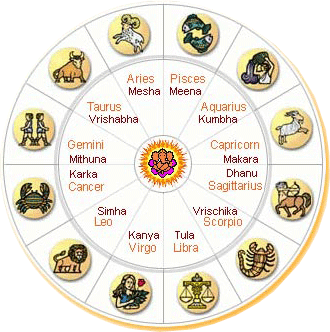
The names of
the Hindu zodiac and corresponding Greek
signs sound very different, being in Sanskrit and Greek
respectively, but it has been long recognised that their symbols are identical. For example,
dhanu means "bow" and corresponds to Sagittarius, the
"archer", and kumbha means "water-pitcher" and corresponds to
Aquarius, the "water-carrier". The correspondence of signs is taken
to suggest the possibility of early interchange of cultural
influences, but while it is generally assumed that the similarity
between the symbols in both systems is because of a Greek
presence c. 50 BC, but it is contended this is supposition, and that
there is clear evidence of trading between the Sumerian and
Babylonian cultures and the Indus Valley Culture millennia
before the Greeks were ever in Asia, and the Sumerians have a
record of Astrological symbols that dated back to c. 2,000 BC.
B. G.
Sidhartha
(14)
points out that there are several references to the zodiac in the Rg
Veda and Mahabharata, both of which are ancient texts which predate
any Greek influence in Asia. He said of it:
'A Rg
Vedic hymn refers to the twelve fixed parts of the wheel and
also to the twelve forms in connection with the sun. The
hymn next describes the twelve lunar months specifically
mentioning the thirteenth additional month required in this
scheme. A Rg Vedic hymn to the Asvins, quoted in the
Mahabharata, also refers to the twelve zodiac signs.
Undoubtedly, the twelve zodiacal signs were known. Other
hymns support this conclusion. This is probably the
origin of the later conception of the twelve Adityas or Sun
Gods'.
(More
about Prehistoric India)
The
Chinese Zodiac:
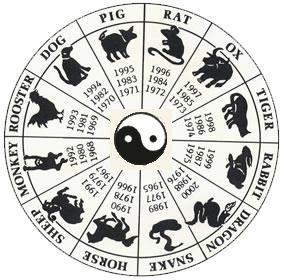 The Chinese animal zodiac, or sheng xiao in
pinyin (literally translated as "born resembling"), is
(rather interestingly) a rotating cycle of 12 years,
with each year being represented by an animal and its
reputed attributes. Scientifically speaking, the
"Chinese Zodiac" could be said of as a way of dividing
the "Jupiter Year" because it takes 12 years for
Jupiter to complete one orbit the sun. The Chinese
calendar counts years in cycles of sixty years. Each
year has a label consisting of two parts. The first
component is the celestial stem being one of the five
elements. The second component is the terrestrial branch
being one of the twelve animal (zodiac) signs. The
equation becomes five multiplied by twelve equalling
sixty, or one cycle in the Chinese calendar.
(3) The Chinese animal zodiac, or sheng xiao in
pinyin (literally translated as "born resembling"), is
(rather interestingly) a rotating cycle of 12 years,
with each year being represented by an animal and its
reputed attributes. Scientifically speaking, the
"Chinese Zodiac" could be said of as a way of dividing
the "Jupiter Year" because it takes 12 years for
Jupiter to complete one orbit the sun. The Chinese
calendar counts years in cycles of sixty years. Each
year has a label consisting of two parts. The first
component is the celestial stem being one of the five
elements. The second component is the terrestrial branch
being one of the twelve animal (zodiac) signs. The
equation becomes five multiplied by twelve equalling
sixty, or one cycle in the Chinese calendar.
(3)
The legend of the
origin of the Chinese zodiac says that Buddha (other versions say the
Jade Emperor of Heaven) once invited all the animals to a race; the
first twelve would be included in the Zodiac calendar.
It�s known from pottery artefacts that the animals of the zodiac were popular in the Tang
Dynasty (618-907 AD), but they were also seen much earlier from
artefacts from the Warring States Period (475-221 BC). It�s been written that the animals of the zodiac were brought to
China via the Silk Road, the same central Asian trade route that
brought the Buddhist belief from India to China. But some scholars
argue that the belief predates Buddhism and has origins in early
Chinese astronomy that used the planet Jupiter as a constant, as its
orbit around the earth took place every 12 years. Still others have
argued that the use of animals in astrology began with nomadic
tribes in ancient China who developed a calendar based on the
animals they used to hunt and gather.
The late date
of origin suggests that the Chinese inherited the Indo-European
concept of the zodiac and adopted it into their own belief
system.
(More
about Prehistoric China)
Astrology is still
considered a pseudo-science in the west, but not in other parts of
the world, such as India for example, where In 2001, Indian
scientists and politicians debated a proposal to use state money to
fund research into astrology, resulting in permission for Indian
universities to offer courses in Vedic astrology. In February 2011,
the Bombay High Court reaffirmed astrology's standing in India when
it dismissed a case which had challenged its status as a science.
(7)
Jung and Astrology:
Jung managed
to bring astrology into the forum of science through his
research into the symbolic meaning of his patient's dreams,
conversations and paintings. Jung observed recurring mythical
themes or archetypes. He proposed that these universal and
timeless archetypes channel experiences and emotions, resulting
in recognizable and typical patterns of behaviour with certain
probable outcomes.
Jung claimed to observe a correlation between these archetypal
images and the astrological themes or traditional 'gods'
associated with the planets and signs of the zodiac. He
concluded that the symbolic heavenly figures described by the
constellations were originally inspired by projections of images
created by the collective unconscious.
Jung's psychological astrology still links the
psyche to the cosmos, but it is not deterministic. Nor
is an individual's everyday life ruled by the positions of the
planets.
He wrote "Astrology represents the sum of all the
psychological knowledge of antiquity".
(8) But he also recognised a
subtle difference with traditional astrology in that he believed
that astrological claims of correlations between the position of
heavenly bodies at the time of birth and an individual's development
were acausal and not actually directly caused by the planets.
Something which led him to develop his concept of Psychological
Astrology, which Jung compared to Aristotle's formal causation,
which posed that "whatever is born or done at this particular moment
of time, has the quality of this moment of time".
In 1949 Bertram Forer
conducted a personality test on students. While seemingly giving
the students individualized results, he instead gave each
student exactly the same sheet that discussed their personality.
The personality descriptions were taken from a book on
Astrology. When the students were asked to comment on the
accuracy of the test with a rating more than 40% gave it the top
mark of 5 out of 5, and the average rating was 4.2. The results
of this study have been replicated in numerous other studies.
(7)
(Archaeoastronomy)
(Precession of the
Equinoxes)
(Landscape Zodiacs)
|
 The
Origin of the Zodiac: (Astrology)
The
Origin of the Zodiac: (Astrology)

 Near to the entrance of the Lascaux
cave complex is a magnificent painting of a bull. Hanging over its
shoulder is what appears (to us) to be a map of the Pleiades, the
cluster of stars sometimes called the Seven Sisters. Inside the bull
painting, there are also indications of spots that may be a
representation of other stars found in that region of sky. Today,
this region forms part of the constellation of Taurus the bull.
Near to the entrance of the Lascaux
cave complex is a magnificent painting of a bull. Hanging over its
shoulder is what appears (to us) to be a map of the Pleiades, the
cluster of stars sometimes called the Seven Sisters. Inside the bull
painting, there are also indications of spots that may be a
representation of other stars found in that region of sky. Today,
this region forms part of the constellation of Taurus the bull.

 The Chinese animal zodiac, or sheng xiao in
pinyin (literally translated as "born resembling"), is
(rather interestingly) a rotating cycle of 12 years,
with each year being represented by an animal and its
reputed attributes. Scientifically speaking, the
"Chinese Zodiac" could be said of as a way of dividing
the "Jupiter Year" because it takes 12 years for
Jupiter to complete one orbit the sun. The Chinese
calendar counts years in cycles of sixty years. Each
year has a label consisting of two parts. The first
component is the celestial stem being one of the five
elements. The second component is the terrestrial branch
being one of the twelve animal (zodiac) signs. The
equation becomes five multiplied by twelve equalling
sixty, or one cycle in the Chinese calendar.
(3)
The Chinese animal zodiac, or sheng xiao in
pinyin (literally translated as "born resembling"), is
(rather interestingly) a rotating cycle of 12 years,
with each year being represented by an animal and its
reputed attributes. Scientifically speaking, the
"Chinese Zodiac" could be said of as a way of dividing
the "Jupiter Year" because it takes 12 years for
Jupiter to complete one orbit the sun. The Chinese
calendar counts years in cycles of sixty years. Each
year has a label consisting of two parts. The first
component is the celestial stem being one of the five
elements. The second component is the terrestrial branch
being one of the twelve animal (zodiac) signs. The
equation becomes five multiplied by twelve equalling
sixty, or one cycle in the Chinese calendar.
(3)